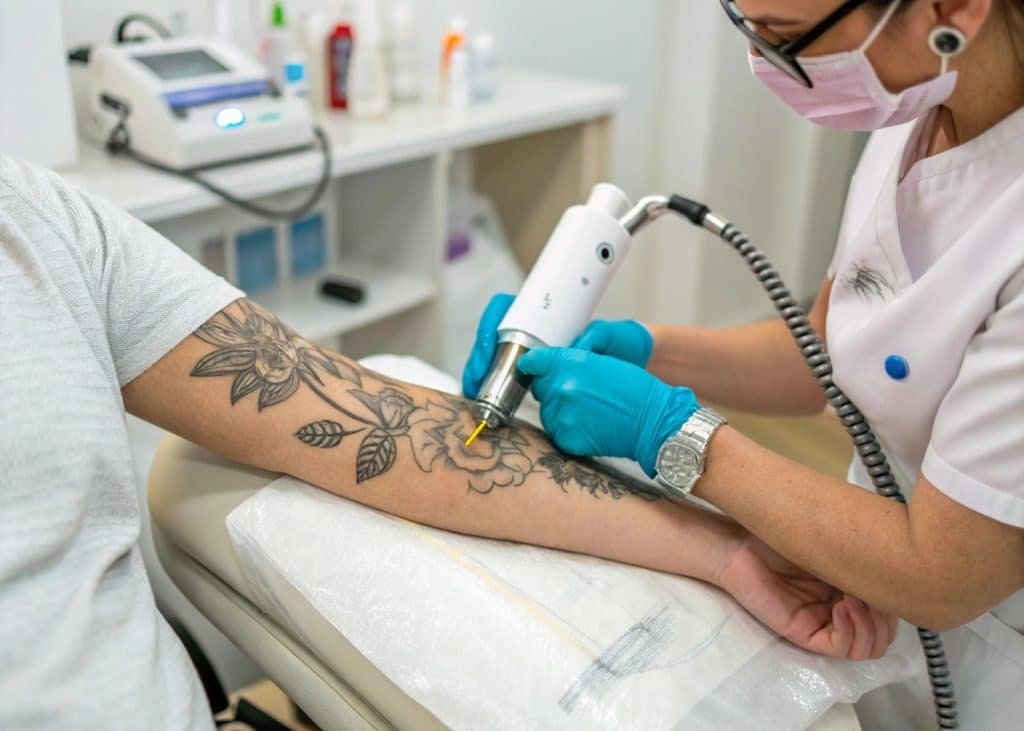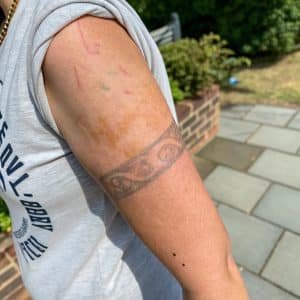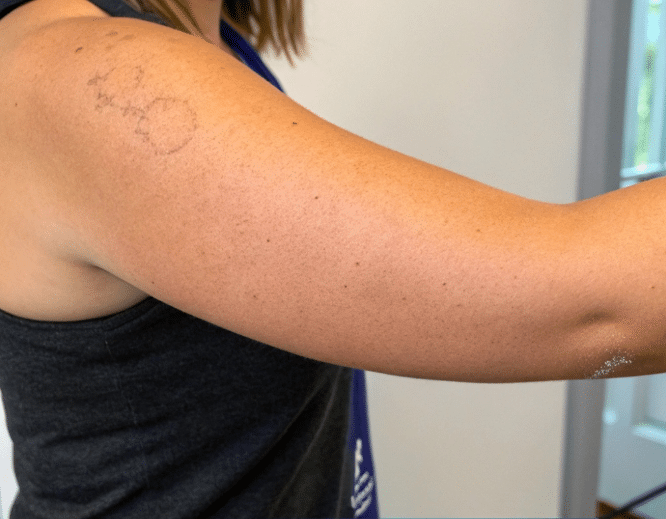Clients are anxious to see results from their laser tattoo removal.They worry about the investment and whether the treatment is effective.Identify key signs of progress to reassure and motivate them.
Laser tattoo removal requires patience. But there are visible signs that indicate the treatment is working. It's important to understand the process and what to expect.

The process will be briefly explained first.
Is Your Laser Tattoo Removal Working? 6 Key Signs of Progress to Track
Clients need reassurance that the process is working.Uncertainty can lead to discouragement and non-compliance.Provide clear, observable indicators of progress.
Laser tattoo removal works by using focused light energy. This shatters the tattoo ink into tiny particles. The body's immune system then gradually removes these particles. This process takes time and multiple sessions.
Note:
| Individual results vary. These depend on several factors. | Factor |
|---|---|
| Ink Characteristics | Color, composition, and density affect removal. Black ink is generally easiest; some colors are more stubborn. |
| Depth | Deeper ink requires more treatments. |
| Individual Health | Overall health, smoking status, and hydration can influence healing and ink clearance. |
| Immune Response | A strong immune system clears fragmented ink more efficiently. |
| Location | Areas with better blood circulation (e.g., face, neck) tend to fade faster than areas with poorer circulation (e.g., hands, feet). |
| Skin Type | Lighter skin types generally respond better and have a lower risk of pigmentary changes; darker skin types require careful treatment to avoid complications. |
Let's explore the key signs:
Sign 1: Fading of the Tattoo Ink: The Most Obvious Indicator?
Clients want to see their tattoo visibly lighter.Lack of fading is the primary reason for concern.
Fading is the most noticeable and desired outcome. It indicates that the laser is successfully breaking down the ink, and the body is removing it.
Details:
- How Does Fading Occur?: The laser shatters the ink into tiny particles. The immune system then gradually clears these particles through the lymphatic system.
- What Does Healthy Fading Look Like?: Gradual lightening of the tattoo over time. It may appear patchy or uneven initially.
- Is It Normal for Some Areas to Fade Faster Than Others?: Yes! Variations in ink depth, density, and color can cause uneven fading.
- Documenting through photography: Take photos every sessions.

Sign 2: Blurring or Softening of the Tattoo Lines: A Subtle but Significant Change?
Clients may not notice subtle changes.They might think the treatment isn't working if they don't see dramatic fading immediately.Explain the significance of blurring.
Blurring or softening of the tattoo lines is often an early sign of progress. It indicates that the ink is starting to break down, even if the overall color hasn't faded significantly yet.
Details:
- Why Does Blurring Happen?: The laser energy begins to disperse the ink particles, causing the sharp lines of the tattoo to become less defined.
- Is Blurring a Precursor to Fading?: Often, yes. Blurring indicates that the ink is breaking down. Fading will likely follow.

Blurring is a positive sign. Now, let's discuss color changes.
Sign 3: Changes in Tattoo Color: A Shift Towards Easier Removal?
Clients may be surprised by color changes during treatment.They might think the treatment is making the tattoo worse.
Changes in the tattoo's color can be a sign that the laser is effectively targeting specific pigments.
Details:
- Why Do Tattoo Colors Change During Treatment?: Different pigments absorb different wavelengths of laser light. As the laser breaks down certain pigments, the overall color of the tattoo may shift.
- What Color Changes are Typically Observed?: Black ink may turn gray or lighter black. Some colors (e.g., red, orange) may initially darken before fading.
- Does a Color Change Mean the Treatment is Working?: Yes, generally. It indicates that the laser is interacting with the ink pigments.
Color Changes
| Original Color | Possible Change | Explanation |
|---|---|---|
| Black | Gray, lighter black | The laser is effectively breaking down the black pigment. |
| Red | Darker red, brown | The red pigment may initially oxidize, appearing darker before fading. |
| Green | Darker green, black | Green pigment can be more challenging to remove and may initially appear darker. |
| Blue | Lighter blue, gray | Blue pigment may fade to a lighter shade or appear grayish as it breaks down. |
| Yellow | May fade directly | Yellow pigment can be difficult to remove and may show less dramatic color changes. |
| White | May fade, no change | Titanium dioxide. |
Color changes are normal. Let's look at changes in texture.
Sign 4: Reduced Tattoo Texture or Raised Appearance: A Return to Normal Skin?
Some tattoos are raised or textured.Clients want their skin to feel smooth again.
Many tattoos have a slightly raised texture. As the laser breaks down the ink and stimulates collagen remodeling, the texture may become smoother and flatter.
Details:
- Why Are Some Tattoos Raised?: Scar tissue formation during the original tattooing process, or a dense concentration of ink, can cause a raised texture.
- How Does Laser Treatment Reduce Texture?: The laser energy not only breaks down ink but also stimulates collagen remodeling. This can help flatten and smooth the skin.
- Is a Flatter Tattoo a Sign of Progress?: Yes! It indicates that the treatment is affecting the deeper layers of the skin.

Texture improvement is a positive sign. Now, let's discuss frosting.
Sign 5: Frosting During Treatment: An Immediate (But Temporary) Indication?
Clients may be alarmed by the white "frosting" that appears during treatment.They might not understand what it is or why it happens.
Frosting is a temporary, white, chalky appearance of the skin that occurs immediately after the laser pulse. It's a good sign, but not a guarantee of long-term success.
Details:
- What is Laser Frosting, and Why Does It Happen?: The laser energy rapidly heats the ink pigment. This causes the formation of gas bubbles (plasma) in the skin. These bubbles scatter light, creating the white appearance.
- Is Frosting a Guarantee of Success?: No. It indicates that the laser is interacting with the ink. But it doesn't guarantee complete removal.
- How Long Does Frosting Typically Last?: Usually just a few minutes.

Frosting is a good sign, but it's temporary. Finally, let's discuss reduced blistering and scabbing.
Sign 6: Fewer Blisters and Scabs After Subsequent Treatments: A Sign of Skin Adaptation?
Clients may experience less blistering and scabbing after later treatments.They might think the treatment is becoming less effective.
As the skin adapts to the laser treatments and the ink load decreases, there may be a reduction in blistering and scabbing after subsequent sessions.
Why the reduction in blistering and scabs?
- Skin Adaptation: The skin becomes more accustomed to the laser energy.
- Reduced Ink Load: Less ink means less energy absorption and less tissue reaction.
- Improved Healing Response: The body's healing response may become more efficient over time.
Is this always a sign of progress?
- Usually, yes. It suggests the skin is tolerating treatment better.
- But... If there's no fading and no blistering/scabbing, it could indicate that the laser settings are too low or the wrong wavelength is being used.
Conclusion
Laser tattoo removal is a gradual process. Multiple signs indicate progress. These include fading, blurring, color changes, texture improvement, frosting, and reduced blistering/scabbing. Open communication with the client, managing expectations, and documenting progress with photos are essential. Tracking these 6 key signs helps both you and your clients see the progress.
